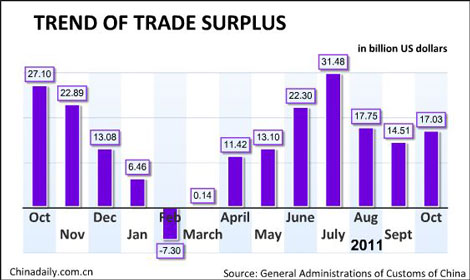China's Oct foreign trade drops 8.3% from Sept
Updated: 2011-11-10 11:08
(Xinhua)
|
|||||||||||

BEIJING - China's imports and exports in October both dropped from September as uncertainties in the United States and Europe cut external demands, the General Administration of Customs (GAC) said Thursday.
China's foreign trade in October this year fell 8.3 percent from September to $297.95 billion but still rose 21.6 percent year-on-year, according to GAC data.
Exports weakened 7.2 percent month-on-month to $157.49 billion in October, while imports dropped 9.5 percent month-on-month to $140.46 billion.
The October trade surplus fell 36.5 percent year-on-year to $17.03 billion, far below the expected $25.8 billion in the market.
"The weakening of export growth in October turned out to be exactly as I expected," said Zhang Yansheng, director of the Institute for International Economics Research of the National Development and Reform Commission, China's top economic planner.
"What we're facing now is a grave situation for exports and slowdown is inevitable in the third and fourth quarters," Zhang said, blaming shrinking external demand, rising costs, liquidity strains and an appreciating yuan.
EU remains top trader
GAC data showed China's foreign trade with its major trading partners -- the European Union (EU), the United States and Japan -- slowed this year, compared to stronger growth in foreign trade with emerging economies.Despite the lingering debt crisis in Europe, the EU remained China's top trading partner during the January-October period, with trade amounting to $466.94 billion, up 20.2 percent year-on-year.
China's trade with the United States increased 16.8 percent from a year ago to $363.03 billion.
Zhang warned Europe and the United States are increasing trade protection measures against China. He cited the latest anti-dumping and counter-vailing investigation into Chinese exports of solar panels by the United States.
A free trade area arrangement between China and the Association of Southeast Asian Nations (ASEAN) helped boost China-ASEAN trade by 25.7 percent year-on-year to $295.91 billion during the period.
China reported a trade deficit of $21.17 billion with ASEAN, up 59.2 percent from a year ago.
The nation exchanged goods and services worth $281.61 billion with Japan in the first 10 months, a year-on-year increase of 17.7 percent. Trade with Australia, Brazil, Russia and South Africa grew much faster than average, increasing by 34.6 percent, 37.4 percent, 43.8 percent and 87 percent, respectively.
During the January-October period, the country's trade surplus narrowed by 15.4 percent year-on-year to $124.02 billion.
Imports grow faster
On a yearly basis, exports were up 15.9 percent in October, while imports growth accelerated to 28.7 percent year-on-year, the GAC said in a statement on its website.Zhang said the 28.7-percent increase in imports underpinned robust growth in domestic demand, spurred by the government's policy to encourage imports.
China's foreign trade is set to hit a historic high this year, as exports and imports in the first 10 months increased 24.3 percent from a year earlier to reach $2.97 trillion, according to the GAC.
Such strong growth might not be sustained, however, according to Zhang Hanlin, head of the China Institute for WTO Sudies with the University of International Business and Economics.
He projected year-on-year export growth to slide further to around 10 percent through to the end of 2012 from October's 15 percent due to the global uncertainties.
Economic fears
Liu Ligang, an economist with ANZ, held a much gloomier view, saying China's exports could fail to achieve two-digit growth in the coming two months due to the escalating euro zone debt crisis.As compared with investment and consumption, Liu said, exports' contribution to China's current GDP growth was almost zero, but a significant decline in exports would affect many industries and fan the unemployment problem.
Fixed-asset investments, which contribute to more than half of China's GDP growth, also posted the slowest growth in October this year, according to data released by the National Bureau of Statistics on Wednesday.
Consumption growth also weakened to a three-month low in October, according to NBS data.
"If all economic engines are losing steam, the risk will rise for China's economy to slide from a softlanding into an abrupt downside trend," Liu said.








